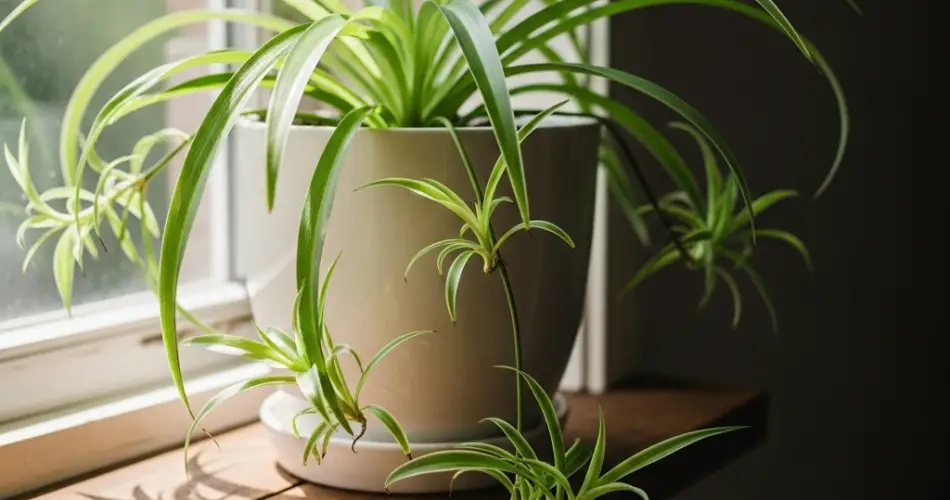The spider plant, scientifically known as Chlorophytum comosum, is one of the most popular and beneficial houseplants worldwide. Known also as the ribbon plant, it’s highly valued not only for its elegant, arching foliage but also for its impressive ability to purify the air. Whether you keep it indoors or outdoors, in your home, garden, kitchen, or bedroom, this resilient plant thrives even in low-light conditions and adds both beauty and health benefits to your living space.
Why the Spider Plant Is So Popular
One of the main reasons the spider plant is loved by gardeners and plant enthusiasts is its easy care and versatility. It tolerates shade much better than many other houseplants, making it ideal for indoor spaces that don’t receive much natural light. This means you can place it in areas where sunlight is limited — such as hallways, bathrooms, or bedrooms — without worrying about its survival.
Beyond its aesthetic appeal, the spider plant has proven air-purifying qualities. Studies, including those by NASA, have shown that it can remove toxins such as formaldehyde, carbon monoxide, and other volatile organic compounds from the air, improving indoor air quality and oxygen levels. This makes it an excellent choice for bedrooms and kitchens where cleaner air is especially beneficial.
Appearance and Growth
The spider plant features long, slender leaves that grow in graceful, arching clumps. The leaves are typically green with white or yellow stripes running down their length, giving the plant a fresh, vibrant look. It produces tiny white flowers on long stems, followed by small “spiderettes” or baby plantlets that dangle like spiders on a web — which is how it got its name.
These spiderettes can be easily propagated by planting them in soil, making the spider plant a great choice for sharing or multiplying your greenery.
Growing Conditions and Care
Spider plants are adaptable and hardy, but to keep yours thriving, here are some important care tips:
Light Requirements
Although spider plants tolerate low light, they do best in bright, indirect sunlight. Avoid placing them in direct sun, which can scorch the leaves. A spot near an east or west-facing window is perfect. In low-light environments, growth may slow, but the plant will generally remain healthy.
Watering
Spider plants prefer moderate watering. The soil should be kept evenly moist but not waterlogged. Water your plant when the top inch of soil feels dry. Overwatering can lead to root rot, so make sure your pot has good drainage.
During winter months, reduce watering since the plant’s growth slows down.
Soil and Potting
Use a well-draining potting mix, such as a standard houseplant or cactus mix. Spider plants do not require heavy or nutrient-rich soil, but good drainage is essential to prevent root rot.
When potting, choose a container with drainage holes. Repot the plant every 1-2 years to refresh the soil and give the roots more room to grow.
Temperature and Humidity
Spider plants thrive in temperatures between 18°C to 24°C (65°F to 75°F). They can tolerate cooler temperatures but should be protected from frost. Average indoor humidity is sufficient, but they appreciate occasional misting in dry environments.
Propagation: Growing New Plants
One of the most enjoyable aspects of owning a spider plant is propagating new plants from the spiderettes. These tiny baby plants develop small roots while still attached to the mother plant.
To propagate:
-
Wait until the spiderette has developed roots about 2-3 cm long.
-
Cut the spiderette from the mother plant using clean scissors.
-
Plant it in a small pot with moist, well-draining soil.
-
Keep the soil damp and place the pot in indirect sunlight.
-
Within a few weeks, the baby plant will establish itself and begin growing.
This simple propagation method allows you to multiply your plants quickly, perfect for gifting or expanding your indoor jungle.
Benefits of Having a Spider Plant at Home
-
Air purification: Spider plants help filter harmful toxins and improve oxygen levels.
-
Easy care: They thrive with minimal attention, ideal for beginners or busy individuals.
-
Aesthetic appeal: Their arching leaves and cascading spiderettes add visual interest.
-
Versatility: Suitable for hanging baskets, pots, or ground cover in gardens.
-
Seasonal resilience: They grow well through spring, summer, fall, and winter.
Common Issues and Troubleshooting
Spider plants are generally tough but can sometimes face problems like:
-
Brown leaf tips: Often caused by fluoride or chlorine in tap water, low humidity, or over-fertilization. Using distilled water and trimming damaged tips can help.
-
Pests: Rarely infested, but they can attract spider mites or aphids. Treat infestations with insecticidal soap or neem oil.
-
Leaf discoloration: Usually a sign of too much direct sun or inconsistent watering.
Final Thoughts
The spider plant is truly a houseplant worth having in any home. Its ability to thrive in shade, purify the air, and multiply quickly makes it a favorite among indoor gardeners. Whether you want to brighten a dim corner or improve your home’s air quality, the spider plant offers both beauty and function with minimal effort.
By understanding its care requirements and appreciating its unique growth habit, you can enjoy this charming and resilient plant for years to come.



